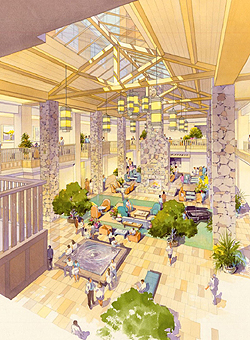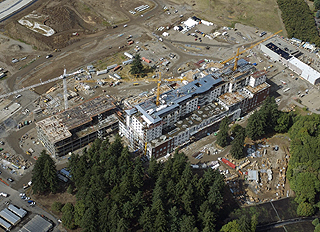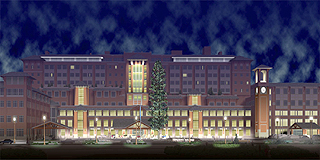
DJC.COM
November 16, 2006
Hotels offer lessons for Oregon hospital
Anshen+Allen

Images courtesy of Anshen+Allen Hotel trappings at Sacred Heart Medical Center in Springfield, Ore. — fireplaces, water features, a coffee shop and an atrium with a grand piano — are designed to offer patients and their families a more comforting environment. |

Kerner
|
Hospital and hospitality share the same root: the Middle English word hospitale. The word originally had two meanings — a place of shelter and rest for travelers, and a charitable institution that provides and cares for the aged, infirm or orphaned.
These meanings come together once again in the design of Sacred Heart Medical Center’s new RiverBend campus in Springfield, Ore.
There has been much discussion of the influence of hospitality design on health care facilities. Sacred Heart may be unique in the lengths to which it has gone to create a hospitality environment in its new facility. Bellevue-based PeaceHealth engaged hospitality and resort architect Wimberly Allison Tong & Goo to work with the health care architect Anshen+Allen.
The resulting facility will be a marriage of the two design disciplines. From the site planning to the front entrance to the patient rooms, Sacred Heart’s integrated design team sought to create a facility capable of providing an ideal experience for patients and families. That theme has been a touchstone throughout the design process, and influenced design decisions over the past four years.
Hotel amenities

The 1.1 million-square-foot Sacred Heart Medical Center complex, which broke ground in 2005, will include an eight-story hospital, two medical office buildings and a pair of parking garages. Senior housing, a wellness center, a conference center and other medical buildings are also planned for the 26-acre site. |
Based on the concept that a hospital should offer many of the amenities and warmth of a quality hotel, the design reflects the best principles of hospitality design in order to offer the patient and family a more comforting experience. At the same time, the facility accommodates all aspects of modern hospital and health care technology.
For example, the operating room of the future is expected to largely integrate imaging and interventional technologies. Procedures will be performed while patients are in the MRI, giving surgeons a more accurate real-time view inside the body as well as the surgical site.
Sacred Heart’s 28 operating rooms are planned in clusters of four that include the future control room — anticipating the addition of the imaging technology. This readies the hospital to adopt this new technology with minimal disruption as it becomes available.
The new medical center will provide views to the outside from every patient room, as well as warm and inviting features for family members and staff such as gardens, fireplaces, riverside jogging trails, a water feature, a comfortable coffee shop and an atrium with a grand piano.
Sacred Heart Medical Center is the cornerstone of the RiverBend campus. After groundbreaking in 2005, construction on the 1.1-million-square-foot facility is due to be completed in 2008. The project, which includes an eight-story, 438-bed hospital, two five-story medical office buildings and two parking garages, will sit amidst towering evergreens on the 26-acre site nestled in the bend of the Mackenzie River in Springfield.
Envisioned as a healing campus for patients, staff and visitors, RiverBend will be developed over the next 15 years, possibly incorporating senior housing, staff housing, and a conference center, in addition to a wellness center and other specialized institutes providing integrated care to patients throughout the Eugene-Springfield region.
Improving outcomes

The hospital, due to be completed in 2008, will have views from every patient room. A study shows that patients recover from surgery more quickly when they can see trees instead of a wall outside their windows. |
Today the importance of a hospitable and healing environment is well accepted by health care facilities. It helps attract patients and it may improve medical outcomes too.
This has not always been the case.
In 1984, Roger Ulrich, a behavioral scientist and professor of architecture, reported the results of a nine-year study showing that patients recovered from surgery faster if they could see trees instead of a wall outside their windows. They required almost a full day less recovery time, fewer pain killers and had lower numbers of post-surgical complications.
Together with the studies of Derek Parker, Kirk Hamilton and others, Ulrich’s work influenced the criteria for accreditation of hospitals implemented by the Joint Commission on Accreditation of Healthcare Organizations. The revised criteria now call for providing “availability of the calming and restorative powers of nature” and “pleasant window views that can be seen by patients from their beds.”
With ongoing shortages of nurses, Sacred Heart Medical Center may also see improved employee retention resulting from the hospitable and attractive working environment. Satisfied staff can better play their part in the ideal patient experience.
With research demonstrating the health and bottom-line benefits of comforting, healing environments, health care organizations such as PeaceHealth have become increasingly savvy about providing a positive hospital or outpatient experience for their customers.
Adam Kerner is a principal with Anshen+Allen, an architecture firm specializing in health care and academic facilities design with offices in Seattle, San Francisco, Boston and London.
Other Stories:
- Hospital gardens help patients heal
- New law encourages hospitals to give patients a lift
- State to adopt national health care design standards
- Quick! Turn an office building into a medical center
- Complex projects call for virtual construction
- Build a better building with 3-D modeling
- Boomers shaping future of health care design
Copyright ©2009 Seattle Daily Journal and DJC.COM.
Comments? Questions? Contact us.